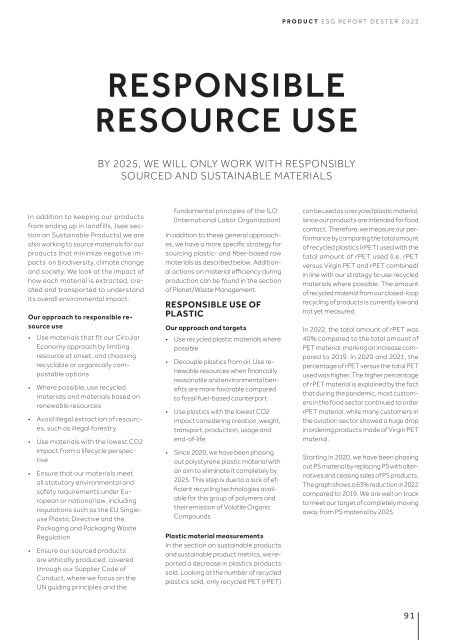deSter Sustainability Report 2022
deSter launched its first-ever Sustainability Report, showcasing deSter's dedication to environmental responsibility, social impact, and ethical governance, reflecting the company's holistic approach toward sustainability.
deSter launched its first-ever Sustainability Report, showcasing deSter's dedication to environmental responsibility, social impact, and ethical governance, reflecting the company's holistic approach toward sustainability.
You also want an ePaper? Increase the reach of your titles
YUMPU automatically turns print PDFs into web optimized ePapers that Google loves.
PRODUCT ESG REPORT DESTER <strong>2022</strong><br />
RESPONSIBLE<br />
RESOURCE USE<br />
BY 2025, WE WILL ONLY WORK WITH RESPONSIBLY<br />
SOURCED AND SUSTAINABLE MATERIALS<br />
In addition to keeping our products<br />
from ending up in landfills, (see section<br />
on Sustainable Products) we are<br />
also working to source materials for our<br />
products that minimize negative impacts<br />
on biodiversity, climate change<br />
and society. We look at the impact of<br />
how each material is extracted, created<br />
and transported to understand<br />
its overall environmental impact.<br />
Our approach to responsible resource<br />
use<br />
• Use materials that fit our Circular<br />
Economy approach by limiting<br />
resource at onset, and choosing<br />
recyclable or organically compostable<br />
options<br />
• Where possible, use recycled<br />
materials and materials based on<br />
renewable resources<br />
• Avoid illegal extraction of resources,<br />
such as illegal forestry<br />
• Use materials with the lowest CO2<br />
impact from a lifecycle perspective<br />
• Ensure that our materials meet<br />
all statutory environmental and<br />
safety requirements under European<br />
or national law, including<br />
regulations such as the EU Singleuse<br />
Plastic Directive and the<br />
Packaging and Packaging Waste<br />
Regulation<br />
• Ensure our sourced products<br />
are ethically produced, covered<br />
through our Supplier Code of<br />
Conduct, where we focus on the<br />
UN guiding principles and the<br />
fundamental principles of the ILO<br />
(International Labor Organization)<br />
In addition to these general approaches,<br />
we have a more specific strategy for<br />
sourcing plastic- and fiber-based raw<br />
materials as described below. Additional<br />
actions on material efficiency during<br />
production can be found in the section<br />
of Planet/Waste Management.<br />
RESPONSIBLE USE OF<br />
PLASTIC<br />
Our approach and targets<br />
• Use recycled plastic materials where<br />
possible<br />
• Decouple plastics from oil. Use renewable<br />
resources when financially<br />
reasonable and environmental benefits<br />
are more favorable compared<br />
to fossil fuel-based counterpart<br />
• Use plastics with the lowest CO2<br />
impact considering creation, weight,<br />
transport, production, usage and<br />
end-of-life<br />
• Since 2020, we have been phasing<br />
out polystyrene plastic material with<br />
an aim to eliminate it completely by<br />
2025. This step is due to a lack of efficient<br />
recycling technologies available<br />
for this group of polymers and<br />
their emission of Volatile Organic<br />
Compounds<br />
Plastic material measurements<br />
In the section on sustainable products<br />
and sustainable product metrics, we reported<br />
a decrease in plastics products<br />
sold. Looking at the number of recycled<br />
plastics sold, only recycled PET (rPET)<br />
can be used as a recycled plastic material,<br />
since our products are intended for food<br />
contact. Therefore, we measure our performance<br />
by comparing the total amount<br />
of recycled plastics (rPET) used with the<br />
total amount of rPET used (i.e. rPET<br />
versus Virgin PET and rPET combined)<br />
in line with our strategy to use recycled<br />
materials where possible. The amount<br />
of recycled material from our closed-loop<br />
recycling of products is currently low and<br />
not yet measured.<br />
In <strong>2022</strong>, the total amount of rPET was<br />
40% compared to the total amount of<br />
PET material, marking an increase compared<br />
to 2019. In 2020 and 2021, the<br />
percentage of rPET versus the total PET<br />
used was higher. The higher percentage<br />
of rPET material is explained by the fact<br />
that during the pandemic, most customers<br />
in the food sector continued to order<br />
rPET material, while many customers in<br />
the aviation sector showed a huge drop<br />
in ordering products made of Virgin PET<br />
material.<br />
Starting in 2020, we have been phasing<br />
out PS material by replacing PS with alternatives<br />
and ceasing sales of PS products.<br />
The graph shows a 63% reduction in <strong>2022</strong><br />
compared to 2019. We are well on track<br />
to meet our target of completely moving<br />
away from PS material by 2025.<br />
91


